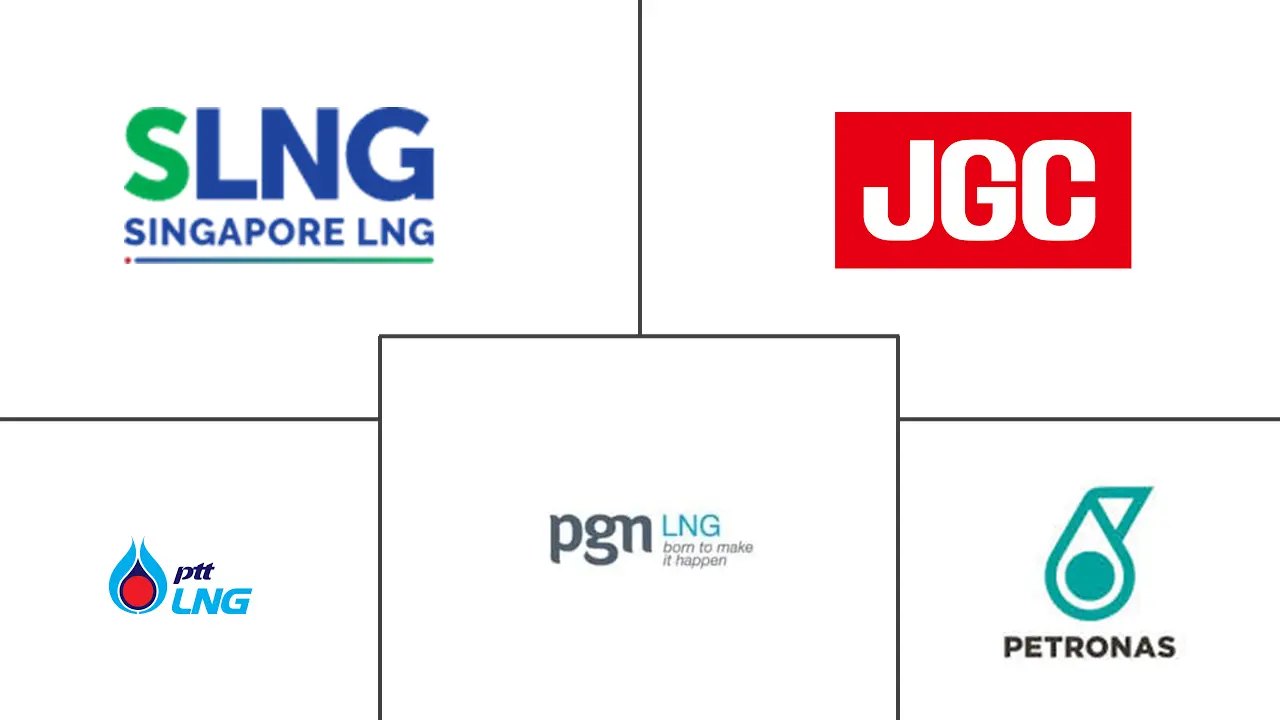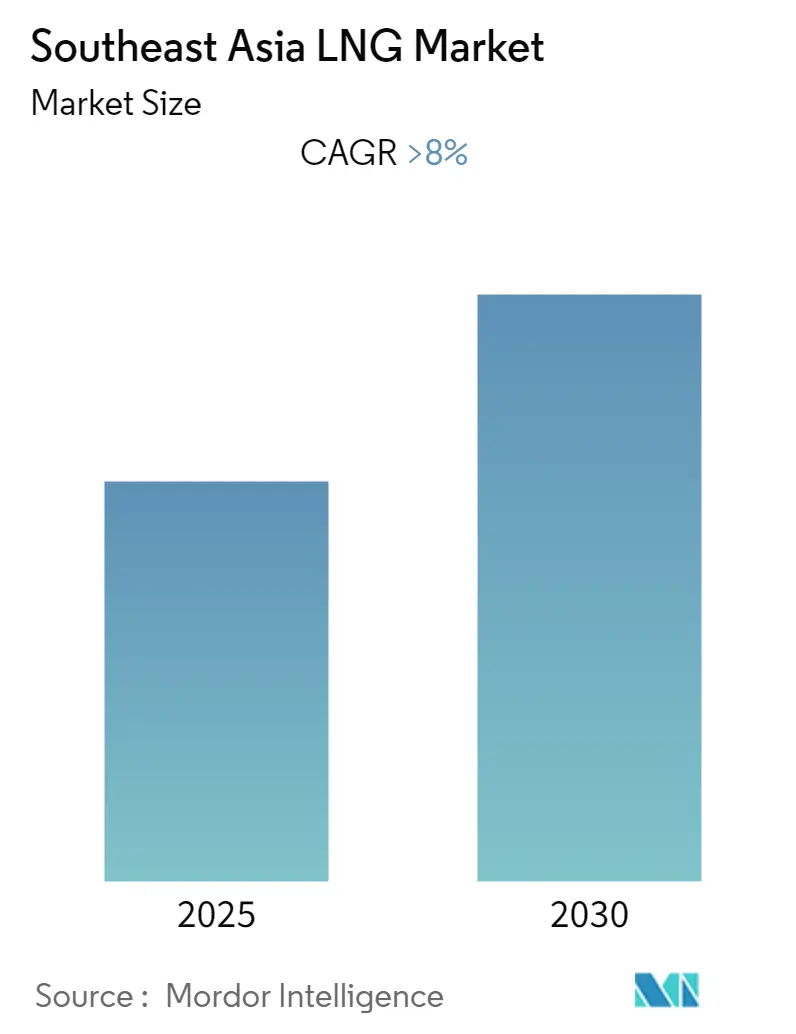
Southeast Asia LNG Market Analysis by Mordor Intelligence
The Southeast Asia LNG Market is expected to register a CAGR of greater than 8% during the forecast period.
COVID-19 negatively impacted the market in 2020. Presently the market has now reached pre-pandemic levels.
- Increasing demand for gas power generation and a rising number of LNG-fueled fleets are expected to drive the Southeast Asian LNG market during the forecast period.
- However, LNG oversupply and trade tension is expected to hamper the market growth during the forecast period.
- A high number of LNG regasification projects/development plans are expected to be proposed in upcoming years, underpinned by the growing LNG demand, leading to the creation of several opportunities for the market players, thus, making an emerging LNG market.
- Singapore is expected to be the largest market during the forecast period owing to the increasing natural gas consumption in the region.
Southeast Asia LNG Market Trends and Insights
Liquefaction Sector to Dominate the Market
- As of 2022, the countries with the largest LNG operational liquefaction capacity in Southeast Asia were Malaysia, Indonesia, and Singapore.
- Indonesia, there are three LNG liquefaction plants currently operating in Indonesia that are the Badak in Bontang, East Kalimantan, Tangguh in West Papua, and Donggi-Senoro in Central Sulawesi, having a combined capacity of 22.5 million tons per annum.
- However, as of 2022, significant capacity expansion in the LNG Liquefication capacity in Indonesia is witnessed. For instance, in September 2022, Indonesian national oil company Pertamina announced the acquisition of Shell's stake in the Inpex-operated proposed Abadi 9.5 million tonnes per annum liquefied natural gas mega-project in the country's remote eastern area. Thus, such upcoming projects will likely drive the market during the forecast period.
- Furthermore, due to the negative impact of the COVID-19 pandemic, global LNG exports decreased by around 22% in June 2020, with countries such as Indonesia and Malaysia. The second half of 2020 registered a significant recovery as LNG export volumes gained momentum, with importing countries easing lockdowns and industrial activities returning to pre-COVID levels.
- In 2021, LNG export gradually decreased in Indonesia, i.e., 14.6 bcm compared to 16.8 bcm in 2020 due to increased domestic demand for LNG.
- Therefore, based on the factors mentioned above, the liquefaction sector is expected to dominate the southeast Asia LNG market during the forecast period.
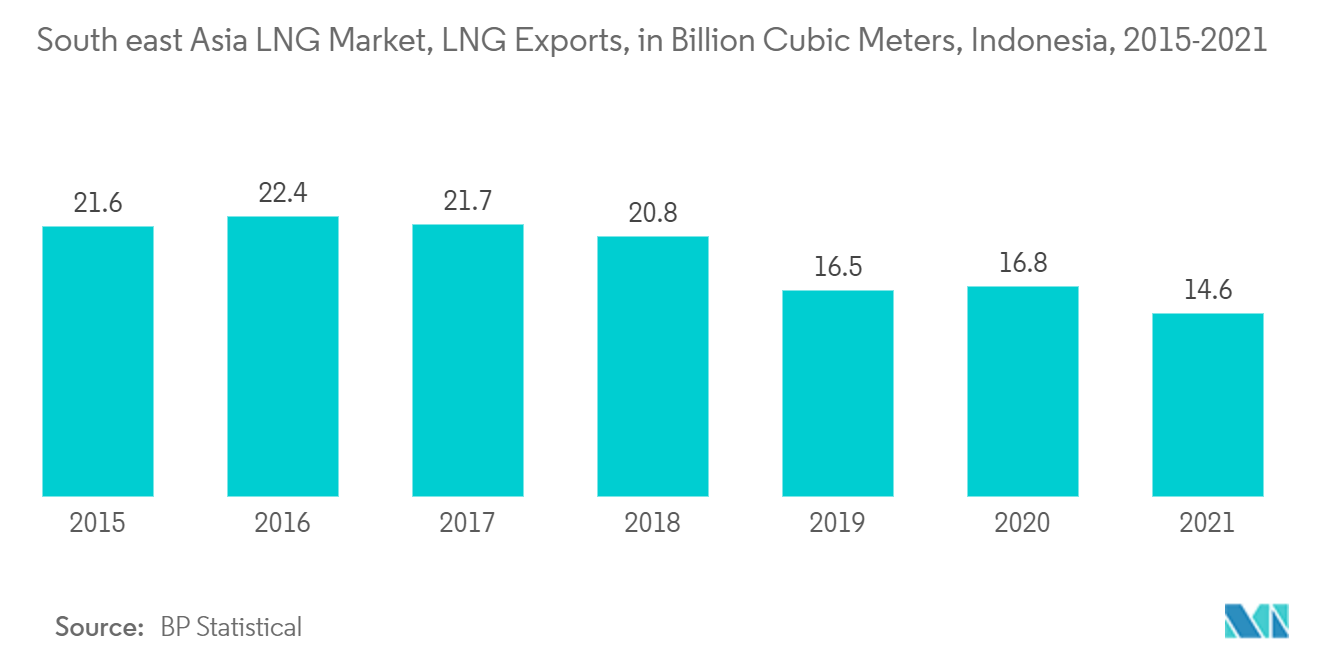
Singapore to Dominate the Market during the forecast period
- Natural gas is one of the options for the energy transition in Singapore. Furthermore, around 95% of electricity is generated from natural gas, as the country has increased reliance on LNG. Singapore does not produce LNG on its own. However, the government aims to become the global hub for LNG trade. Singapore is already a global hub for petroleum products in Asia. LNG is critical to the Singapore government's future economic development and energy security plans. In 2021, Singapore imported around 3.1 million tons of LNG.
- Singapore has one of the leading trade ports and is one of the global leaders in international marine shipping. In addition, the Straits of Malacca and the Singapore Strait, adjacent to Singapore, have become an integral passages for maritime transport, with many tankers, containers, cargo, and passenger ships, halting at Singapore and relying on the ports for resupplies of water, food, crew changes, and fuel refilling. Because of its strategic location, LNG as a bunkering fuel is expected to support the growth of LNG businesses in Singapore during the study period.
- To support the IMO 2020 regulations and to meet the rising demand for LNG as a fuel in the shipping industry, Singapore is likely to increase the LNG supply to its ports. The development of LNG as a fuel was initiated in Singapore before IMO 2020 imposed in 2017 when Singapore LNG Corporation Pte Ltd (SLNG) successfully loaded around 6,500 cubic meters to an LNG bunker vessel owned by Shell and co-financed by the European Union in Jurong Island.
- In May 2021, LNG and the Maritime Port Authority of Singapore completed the first bunkering of an LNG-fueled oil tanker in Singapore. Further, FueLNG announced its plans to provide 30 to 50 ship-to-ship LNG bunkering operations in 2021. Besides the Pacific Emerald tankers, FueLNGhas also lined up bunkering operations for containerships, chemical oil tankers, and bulk carriers. MPA 2020 inducted one LNG bunker vessel named FueLNG Bellina to promote LNG as a marine fuel. Further, the authority has plans to establish two more LNG bunker fuel tankers in 2021 and 2022. The upcoming LNG bunker vessel is expected to have a capacity of around 30,000 cubic meters.
- Furthermore, Singapore initiated LNG trucks in 2017. Singapore LNG Corporation and the Maritime and Port Authority of Singapore launched the LNG truck loading facility at the SLNG Terminal on Jurong Island. The LNG loaded on the trucks is sent to various industrial locations with no natural gas pipeline infrastructure. Additionally, the country is concentrating on having LNG-fueled trucks to control rising carbon emissions. By the end of 2021, PSA Corporation Limited inducted 160 LNG-fueled trucks for its various operations.
- Overall, the growing demand for LNG from the maritime and transportation sectors will likely boost LNG business in Singapore during the study period.
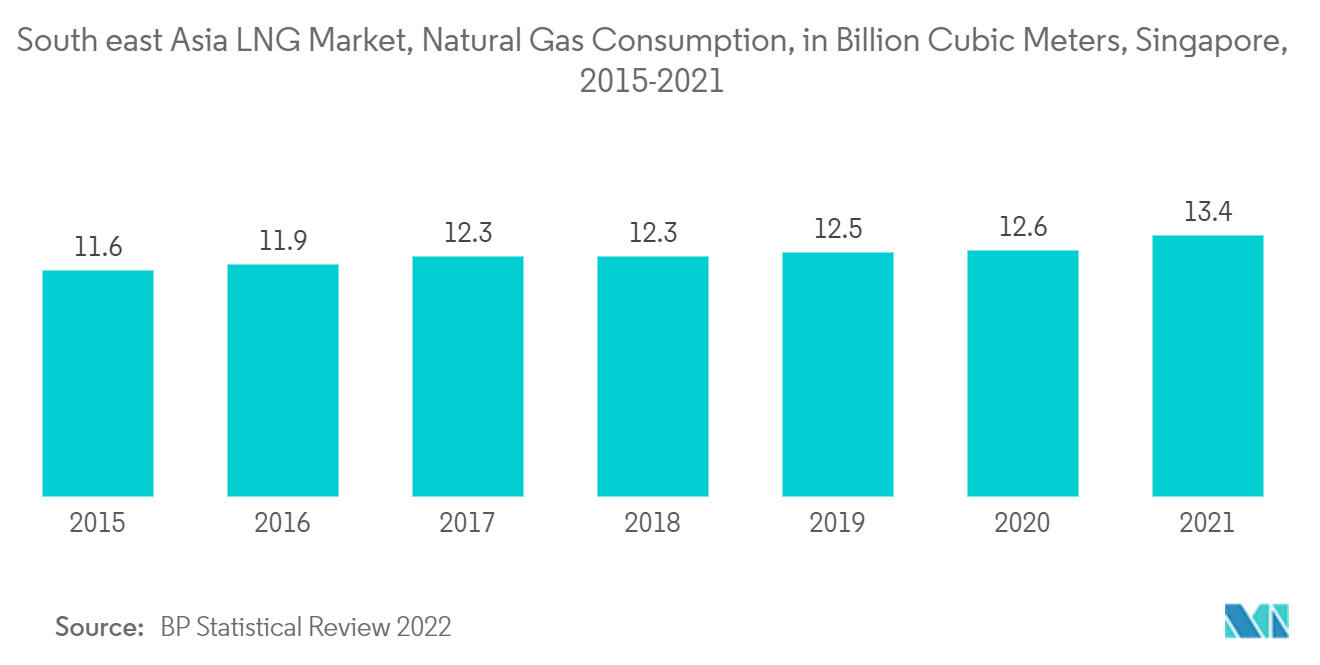
Competitive Landscape
The Southeast Asia LNG market is moderately Consolidated. Some of the major players include Petronas, Singapore LNG Corporation Pte Ltd, JGC Holding Corporation, PTT LNG Co Ltd, and PT PGN LNG Indonesia, among others.
Southeast Asia LNG Industry Leaders
-
Petronas
-
Singapore LNG Corporation Pte Ltd
-
JGC Holding Corporation
-
PTT LNG Co Ltd
-
PT PGN LNG Indonesia
- *Disclaimer: Major Players sorted in no particular order
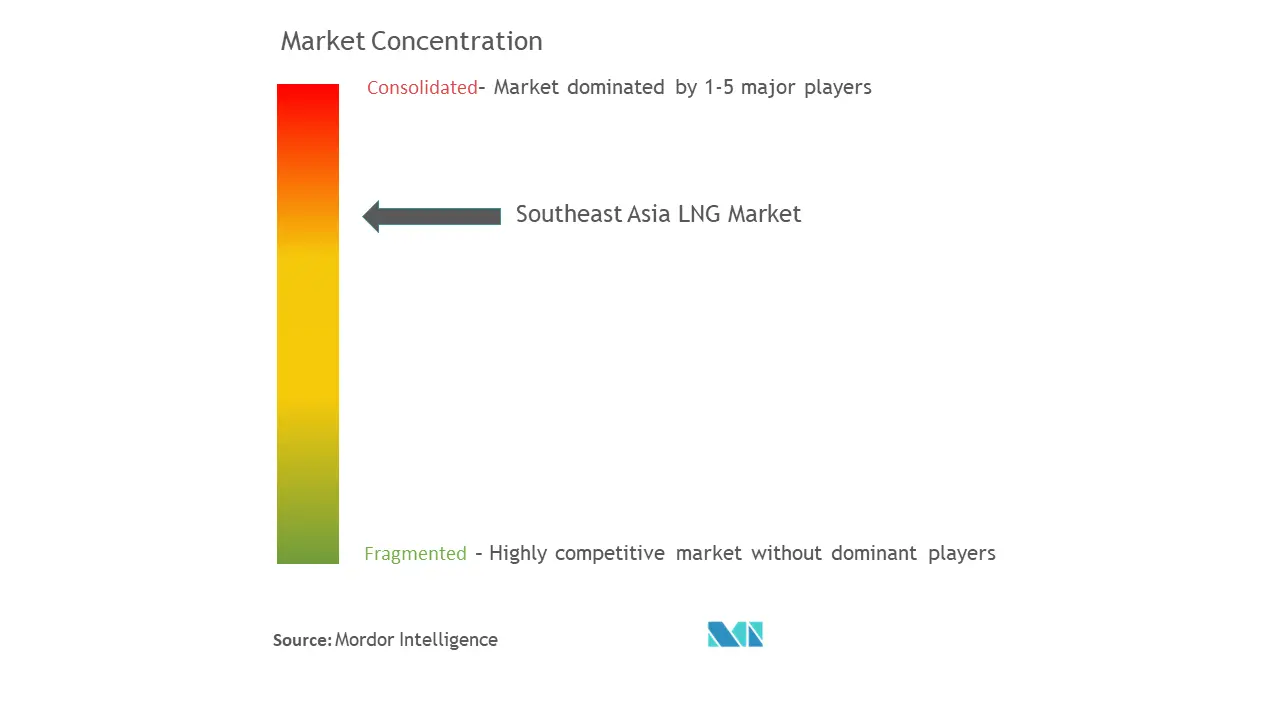
Recent Industry Developments
- In September 2022, Indonesian national oil company Pertamina announced the acquisition of Shell's stake in the Inpex-operated proposed Abadi 9.5 million tonnes per annum liquefied natural gas mega-project in the country's remote eastern area. Thus, such upcoming projects will likely drive the market during the forecast period.
- In June 2021, the Indonesian state energy company planned to develop LNG bunkering with the help of its two units, PT Perusahaan Gas Negara (PGN) and PT Pertamina International Shipping (PIS). In order to boost LNG fuel ships in the country, PIS is likely to operate five LNG fuel vessels, while PGN would provide LNG supply and LNG bunkering facilities in the country.
Southeast Asia LNG Market Report Scope
LNG is natural gas that has been cooled to a liquid state, at about -260° F, for storage and shipping. The volume of natural gas in its liquid form is about 600 times smaller than in its gaseous state. This process makes it possible to transport natural gas to places pipelines do not reach. The LNG market is segmented by LNG infrastructure and LNG trade. By LNG infrastructure, the market is segmented into LNG liquefaction plants, LNG regasification facilities, and LNG shipping. The report also covers the market size and forecasts for the LNG market across major regions. for each segment, the market sizing and forecasts have been done based on revenue (USD million).
| LNG Liquefaction Plants |
| LNG Regasification Plants |
| LNG Shipping |
| Singapore |
| Indonesia |
| Thailand |
| Malaysia |
| Others |
| LNG Infrastrucutre | LNG Liquefaction Plants |
| LNG Regasification Plants | |
| LNG Shipping | |
| Geography | Singapore |
| Indonesia | |
| Thailand | |
| Malaysia | |
| Others |
Key Questions Answered in the Report
What is the current Southeast Asia LNG Market size?
The Southeast Asia LNG Market is projected to register a CAGR of greater than 8% during the forecast period (2025-2030)
Who are the key players in Southeast Asia LNG Market?
Petronas, Singapore LNG Corporation Pte Ltd, JGC Holding Corporation, PTT LNG Co Ltd and PT PGN LNG Indonesia are the major companies operating in the Southeast Asia LNG Market.
What years does this Southeast Asia LNG Market cover?
The report covers the Southeast Asia LNG Market historical market size for years: 2020, 2021, 2022, 2023 and 2024. The report also forecasts the Southeast Asia LNG Market size for years: 2025, 2026, 2027, 2028, 2029 and 2030.
Page last updated on:
Southeast Asia LNG Market Report
Statistics for the 2025 Southeast Asia LNG market share, size and revenue growth rate, created by Mordor Intelligence™ Industry Reports. Southeast Asia LNG analysis includes a market forecast outlook for 2025 to 2030 and historical overview. Get a sample of this industry analysis as a free report PDF download.
